
Why xlock? Well it all has to do with life.

 I started developing xlock because I had a few demos, including
the bounce mode
I started developing xlock because I had a few demos, including
the bounce mode
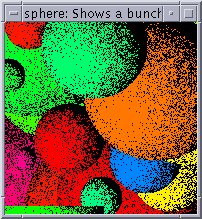 and the sphere mode
and the sphere mode
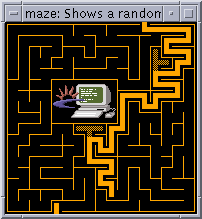 and the maze mode from Sun.
I wanted to have these modes used instead to lock the screen,
and the maze mode from Sun.
I wanted to have these modes used instead to lock the screen,
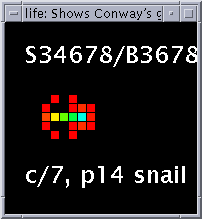 but mainly I wanted to improve the life mode.
(The life mode is a grid of cells each following a specific rule.
When specific "interesting" rules are used it seems like the grid is alive.)
So I added new rules, new life forms for the old rule, and triangular and
hexagonal grids. Patrick Naughton, the original author of xlock,
had no problems with me maintaining his program on the internet.
Before long I was getting new modes sent to me from all over the world,
writing new modes and "stealing" others from hacks from xscreensaver.
One big regret, I chose the name name "xlockmore" to differentiate
it from the original... but I am stuck with that now.
but mainly I wanted to improve the life mode.
(The life mode is a grid of cells each following a specific rule.
When specific "interesting" rules are used it seems like the grid is alive.)
So I added new rules, new life forms for the old rule, and triangular and
hexagonal grids. Patrick Naughton, the original author of xlock,
had no problems with me maintaining his program on the internet.
Before long I was getting new modes sent to me from all over the world,
writing new modes and "stealing" others from hacks from xscreensaver.
One big regret, I chose the name name "xlockmore" to differentiate
it from the original... but I am stuck with that now.
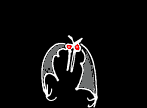 For example, the silly animated bat mode sent to me by "Patol",
which is actually the bounce mode in disguise.
For example, the silly animated bat mode sent to me by "Patol",
which is actually the bounce mode in disguise.
 A neat idea was the -use3d option added to modes like bouboule mode
(written by Jeremie Petit), thanks to Henrik Theiling,
where you need red and blue 3D glasses to appreciate it.
(Unfortunately adding another color, green, will not help us see 4D
since we only have at most 2 eyes).
A neat idea was the -use3d option added to modes like bouboule mode
(written by Jeremie Petit), thanks to Henrik Theiling,
where you need red and blue 3D glasses to appreciate it.
(Unfortunately adding another color, green, will not help us see 4D
since we only have at most 2 eyes).
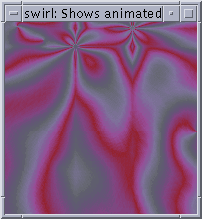 An innovative mode was the swirl mode by M. Dobie and R. Taylor
which cycled the screen for Pseudocolor displays.
An innovative mode was the swirl mode by M. Dobie and R. Taylor
which cycled the screen for Pseudocolor displays.
 A bigger break through mode was the gears mode by Brian Paul and Dany Sung,
which opened the door for many neat modes from OpenGL and MESA. Here it
is improved by Jamie Zawinski showing a planetary gear.
A bigger break through mode was the gears mode by Brian Paul and Dany Sung,
which opened the door for many neat modes from OpenGL and MESA. Here it
is improved by Jamie Zawinski showing a planetary gear.
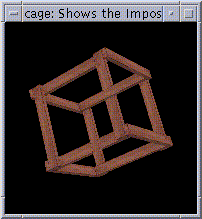
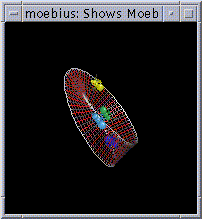
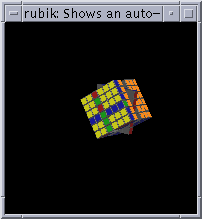 This was followed by a flurry of great modes by Marcelo Fernandes Vianna.
Here are a few of them.
This was followed by a flurry of great modes by Marcelo Fernandes Vianna.
Here are a few of them.
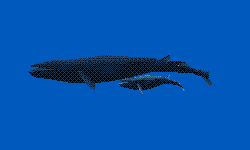
 atlantis and lament OpenGL modes thanks to Eric Lassauge and Jamie Zawinski.
atlantis and lament OpenGL modes thanks to Eric Lassauge and Jamie Zawinski.
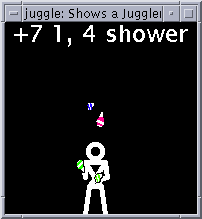 As a juggle enthusiast myself, I really like the juggle mode by Tim Auckland.
As a juggle enthusiast myself, I really like the juggle mode by Tim Auckland.
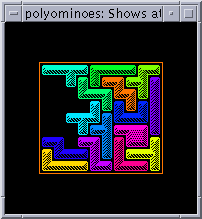 I mostly enjoy the mathematical modes such as
the polyominoes mode by Stephen Montgomery-Smith,
which enventually will solve known "solvable" polyomino puzzles,
I mostly enjoy the mathematical modes such as
the polyominoes mode by Stephen Montgomery-Smith,
which enventually will solve known "solvable" polyomino puzzles,
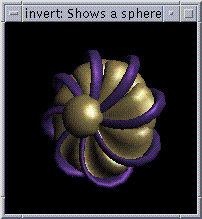 the OpenGL invert mode by Tim Rowley and the Geometry Center,
which inverts a sphere without creasing where it is
permissible for the surfaces to go through each other,
the OpenGL invert mode by Tim Rowley and the Geometry Center,
which inverts a sphere without creasing where it is
permissible for the surfaces to go through each other,
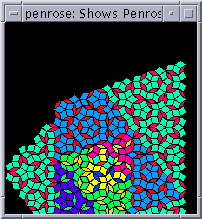 and the penrose mode by Timo Korvola,
which covers the plane with penrose tiles.
and the penrose mode by Timo Korvola,
which covers the plane with penrose tiles.
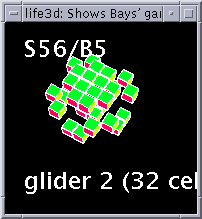 The two modes I spend the most time watching though are
the life3d mode
The two modes I spend the most time watching though are
the life3d mode
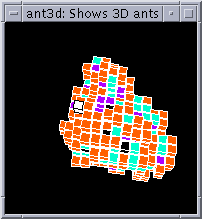 and the ant3d mode which are written by Anthony Wesley and David Bagley.
and the ant3d mode which are written by Anthony Wesley and David Bagley.
xlock(more) is more than just the modes, there are a few password mechanisms
and public lab switches that can be chosen to be compiled in.
I eagerly accept patches and improvements and ports for xlock,
I would rather get a new interesting modes. :)
Many people have helped me maintain this over the years,
most notably Jouk (Jacob) Jansen and Tom Schmidt.
There are 100+ modes so I am sorry if I neglected to mention
a personal favorite.
Send comments/suggestions to:
Maintainer's
mail
Maintainer's Home Page
Last Revised: 19 September 2016


 I started developing xlock because I had a few demos, including
the bounce mode
I started developing xlock because I had a few demos, including
the bounce mode
 and the sphere mode
and the sphere mode
 and the maze mode from Sun.
I wanted to have these modes used instead to lock the screen,
and the maze mode from Sun.
I wanted to have these modes used instead to lock the screen,
 but mainly I wanted to improve the life mode.
(The life mode is a grid of cells each following a specific rule.
When specific "interesting" rules are used it seems like the grid is alive.)
So I added new rules, new life forms for the old rule, and triangular and
hexagonal grids. Patrick Naughton, the original author of xlock,
had no problems with me maintaining his program on the internet.
Before long I was getting new modes sent to me from all over the world,
writing new modes and "stealing" others from hacks from xscreensaver.
One big regret, I chose the name name "xlockmore" to differentiate
it from the original... but I am stuck with that now.
but mainly I wanted to improve the life mode.
(The life mode is a grid of cells each following a specific rule.
When specific "interesting" rules are used it seems like the grid is alive.)
So I added new rules, new life forms for the old rule, and triangular and
hexagonal grids. Patrick Naughton, the original author of xlock,
had no problems with me maintaining his program on the internet.
Before long I was getting new modes sent to me from all over the world,
writing new modes and "stealing" others from hacks from xscreensaver.
One big regret, I chose the name name "xlockmore" to differentiate
it from the original... but I am stuck with that now.
 For example, the silly animated bat mode sent to me by "Patol",
which is actually the bounce mode in disguise.
For example, the silly animated bat mode sent to me by "Patol",
which is actually the bounce mode in disguise.
 A neat idea was the -use3d option added to modes like bouboule mode
(written by Jeremie Petit), thanks to Henrik Theiling,
where you need red and blue 3D glasses to appreciate it.
(Unfortunately adding another color, green, will not help us see 4D
since we only have at most 2 eyes).
A neat idea was the -use3d option added to modes like bouboule mode
(written by Jeremie Petit), thanks to Henrik Theiling,
where you need red and blue 3D glasses to appreciate it.
(Unfortunately adding another color, green, will not help us see 4D
since we only have at most 2 eyes).
 An innovative mode was the swirl mode by M. Dobie and R. Taylor
which cycled the screen for Pseudocolor displays.
An innovative mode was the swirl mode by M. Dobie and R. Taylor
which cycled the screen for Pseudocolor displays.
 A bigger break through mode was the gears mode by Brian Paul and Dany Sung,
which opened the door for many neat modes from OpenGL and MESA. Here it
is improved by Jamie Zawinski showing a planetary gear.
A bigger break through mode was the gears mode by Brian Paul and Dany Sung,
which opened the door for many neat modes from OpenGL and MESA. Here it
is improved by Jamie Zawinski showing a planetary gear.


 This was followed by a flurry of great modes by Marcelo Fernandes Vianna.
Here are a few of them.
This was followed by a flurry of great modes by Marcelo Fernandes Vianna.
Here are a few of them.

 atlantis and lament OpenGL modes thanks to Eric Lassauge and Jamie Zawinski.
atlantis and lament OpenGL modes thanks to Eric Lassauge and Jamie Zawinski.
 As a juggle enthusiast myself, I really like the juggle mode by Tim Auckland.
As a juggle enthusiast myself, I really like the juggle mode by Tim Auckland.
 I mostly enjoy the mathematical modes such as
the polyominoes mode by Stephen Montgomery-Smith,
which enventually will solve known "solvable" polyomino puzzles,
I mostly enjoy the mathematical modes such as
the polyominoes mode by Stephen Montgomery-Smith,
which enventually will solve known "solvable" polyomino puzzles,
 the OpenGL invert mode by Tim Rowley and the Geometry Center,
which inverts a sphere without creasing where it is
permissible for the surfaces to go through each other,
the OpenGL invert mode by Tim Rowley and the Geometry Center,
which inverts a sphere without creasing where it is
permissible for the surfaces to go through each other,
 and the penrose mode by Timo Korvola,
which covers the plane with penrose tiles.
and the penrose mode by Timo Korvola,
which covers the plane with penrose tiles.
 The two modes I spend the most time watching though are
the life3d mode
The two modes I spend the most time watching though are
the life3d mode
 and the ant3d mode which are written by Anthony Wesley and David Bagley.
and the ant3d mode which are written by Anthony Wesley and David Bagley.